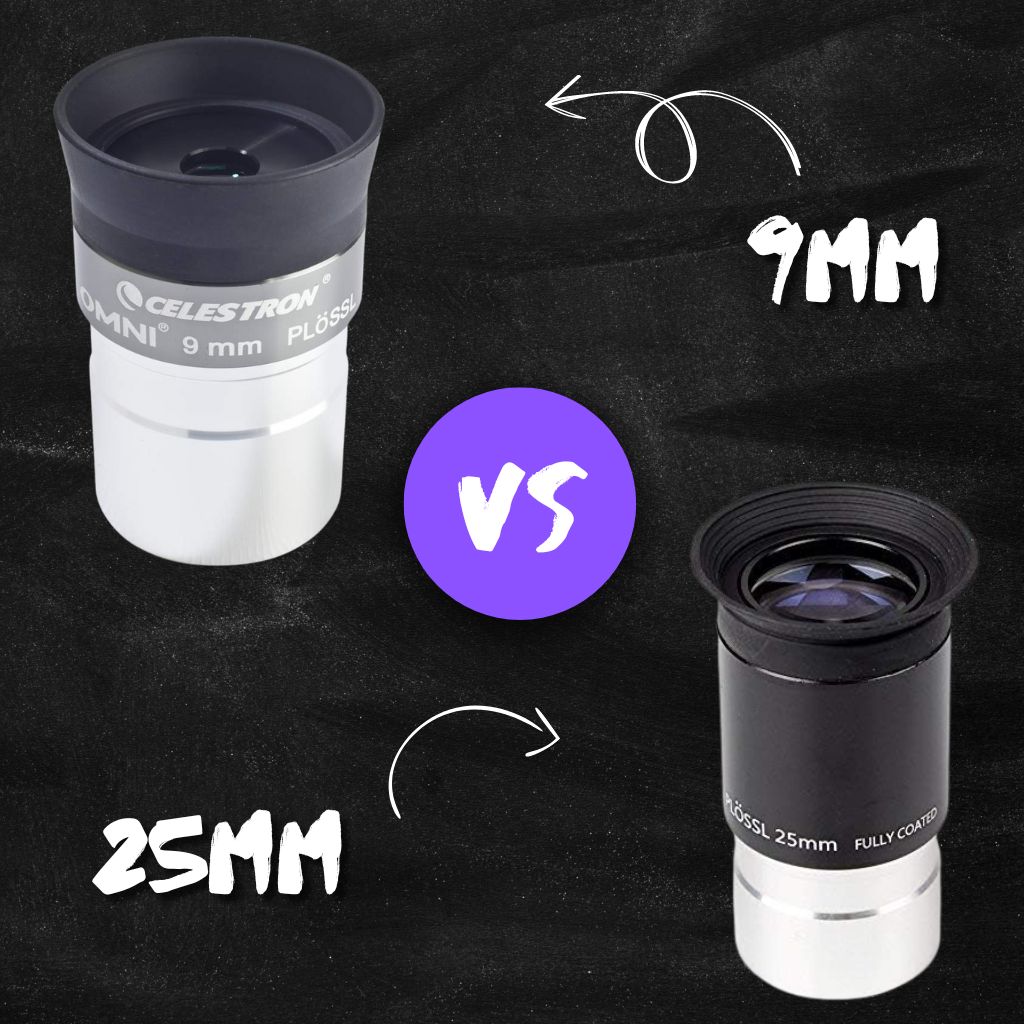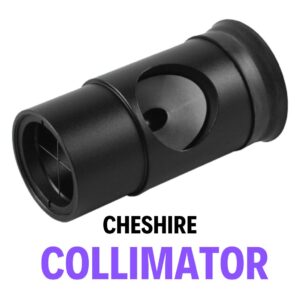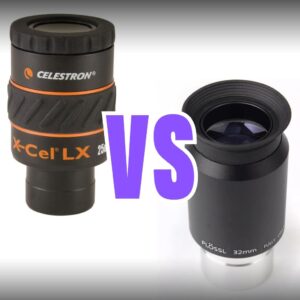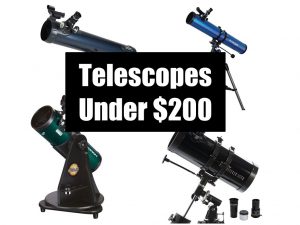This site contains affiliate links to products. I may receive a commission for purchases made through these links.
The brilliance of your astronomical observations often hinges on the quality and specifications of your telescope eyepieces. Two popular options, the 9mm, and 25mm eyepieces, offer distinct features and advantages that cater to different observing needs.
The 9mm eyepiece offers higher magnification for detailed views of planets and lunar craters, while the 25mm eyepiece provides a wider field of view for observing star clusters and galaxies.
Understanding these differences is crucial when deciding which one to purchase.
This article will delve into their key differences, pros, and cons and guide you toward making an informed decision.
9mm vs 25mm eyepiece: Which is better?
Deciding between a 9mm and a 25mm eyepiece isn’t a matter of one being universally better than the other. It comes down to the intended application and the type of observations you plan to undertake.
A 9mm eyepiece, with its higher magnification, is better suited for observing small and distant objects like planets or distant galaxies.
The 25mm eyepiece, on the other hand, provides a wider field of view, making it a preferred choice for viewing larger deep-sky objects like nebulae and star clusters.
Key differences between a 9mm and a 25mm eyepiece
These eyepieces have some differences that can significantly impact your observing experience.
Let’s look at them in detail.
9mm eyepiece provides a higher magnification than a 25mm eyepiece
The primary difference between a 9mm and a 25mm eyepiece lies in their magnification power. A 9mm eyepiece will provide higher magnification compared to a 25mm eyepiece on the same telescope.
The magnification of an eyepiece is calculated by dividing the focal length of the telescope by the focal length of the eyepiece.
25mm eyepiece has a wider field of view than a 9mm eyepiece
The 25mm eyepiece generally offers a wider field of view, making it a good choice for viewing larger deep sky objects or sweeping the Milky Way.
A 9mm eyepiece, with its narrower field of view, is better for zooming in on smaller celestial objects.
25mm eyepiece provides brighter images than a 9mm eyepiece
A 25mm eyepiece will generally give you a brighter image than a 9mm eyepiece because it allows more light to enter your eye, which can be particularly beneficial when observing faint deep sky objects.
25mm eyepiece has generous eye relief compared to a 9mm eyepiece
Eye relief refers to the distance from the eyepiece at which you can still see the full field of view. Longer focal length eyepieces, like 25mm, tend to have more generous eye relief, making them more comfortable to use, especially for people who wear glasses.
Is a 9mm eyepiece good for a telescope?
A 9mm eyepiece is valuable to a telescope as it provides higher magnification, allowing for detailed observations of celestial objects.
However, its suitability depends on various factors, such as the telescope’s focal length, the atmospheric conditions, and the observer’s experience and preferences.
The 9mm eyepiece may result in a narrower field of view, making it more suitable for objects that require closer scrutiny rather than wide-field observations.
What can you see with a 9mm eyepiece?
A 9mm eyepiece, due to its higher magnification, excels in delivering detailed views of distant or smaller celestial objects. It provides a closer look at planetary surfaces, enabling observers to discern features such as Jupiter’s bands, Saturn’s rings, or Mars’ polar ice caps.
It is also an excellent tool for lunar observation, offering a detailed examination of the Moon’s craters, valleys, and mountains.
In addition, deep-sky objects like distant galaxies and nebulae can also be observed with a 9mm eyepiece, although their view might be less extensive due to the narrower field of view compared to wider eyepieces.
Here are some recommended 9mm eyepiece models:
Celestron X-Cel LX Series 9mm Eyepiece
The Celestron X-Cel LX Series 9mm eyepiece features a comfortable 60-degree apparent field of view and six-element fully multi-coated optics, delivering sharp and clear views.
The eyepiece is constructed with durable aluminum housing and includes a twist-up eyecup for added convenience.
With its high-quality optics and reliable performance, the Celestron X-Cel LX Series 9mm eyepiece is a top recommended option.
SVBONY 9mm telescope eyepiece
The SVBONY Telescopes Eyepiece is a 1.25-inch eyepiece with a 68-degree ultra-wide angle design, making it a versatile and high-quality accessory for telescopes.
The 9mm focal length increases magnification, allowing astronomers to observe celestial objects with greater detail.
The eyepiece is multi-coated, enhancing light transmission and reducing glare for clear and crisp views.
Its durable construction and excellent performance make it a thoughtful and practical gift for anyone passionate about astronomy.
Astromania 1.25″ 9mm 58-Degree Planetary Eyepiece
The Astromania 1.25″ 9mm 58-Degree Planetary Eyepiece is a specialized accessory designed for observing planets and other celestial objects in detail.
With its 58-degree field of view, this eyepiece provides a comfortable viewing experience and allows for high-resolution views of planetary features.
The 9mm focal length offers increased magnification, enabling astronomers to explore intricate details on the surfaces of planets, such as Jupiter’s cloud bands or Saturn’s rings.
The eyepiece is compatible with most standard 1.25″ telescope focusers, and its multi-coated optics ensure optimal light transmission and image quality.
Is a 25mm eyepiece good for a telescope?
A 25mm eyepiece is considered a versatile and commonly used option for telescopes. It provides a moderate magnification that balances a wide field of view and sufficient detail in observing astronomical objects.
It offers a wider field of view compared to eyepieces with shorter focal lengths, making it ideal for observing larger celestial objects.
What can you see with a 25mm eyepiece?
With a 25mm eyepiece, you can see expansive celestial bodies such as the Andromeda Galaxy, our Milky Way’s closest spiral galaxy.
This eyepiece’s broad field of view also lends itself perfectly to observing the extensive Orion Nebula located in Orion’s ‘sword.’
The large star clusters, like the Pleiades, also known as the Seven Sisters, are better appreciated with this eyepiece due to their considerable size and the lower magnification of the 25mm eyepiece, which allows the entire cluster to be seen at once.
Explore Scientific 25mm 100° Eyepiece
Explore Scientific 25mm 100° Eyepiece offers a wide field of view and exceptional optical performance. It features comfortable eye relief, fully multi-coated lenses, and a waterproof design.
It is highly recommended for both beginners and experienced astronomers.
Celestron X-Cel LX Series 25mm Eyepiece
Celestron X-Cel LX Series 25mm Eyepiece features a six-element fully multi-coated optical design, providing a wide field of view and excellent image quality.
It has comfortable eye relief and is compatible with various telescope models.
Orion Sirius Plossl 25mm Eyepiece
With its generous 68-degree apparent field of view, Orion 25mm Eyepiece provides immersive and detailed views of celestial objects.
It has a long eye relief and is suitable for both visual observations and astrophotography.
How do I choose the right telescope eyepieces?
Selecting the ideal telescope eyepiece is crucial for optimizing your stargazing adventures.
Several factors come into play when making this decision, such as:
Eyepiece focal length
The eyepiece focal lengths play a crucial role in determining the magnification and field of view you’ll achieve. Short focal length eyepieces, such as a 9mm eyepiece, will provide higher magnification, allowing for closer views of celestial objects.
On the other hand, a longer focal length eyepiece, like a 25mm eyepiece, will offer lower magnification but a wider field of view, making it ideal for observing larger objects or capturing panoramic views of the night sky.
Magnification
Choosing the right magnification is important for observing different celestial objects. Higher magnification, achievable with a 9mm eyepiece, is useful for detailed views of planets, lunar features, and double stars.
Lower magnification, provided by a 25mm eyepiece, is better suited for observing large deep-sky objects like nebulae and star clusters and scanning the night sky for celestial events.
Field of view
The apparent field of view (AFoV) determines the width of the observable sky through the eyepiece. Eyepieces with wider AFoV, such as some wide-angle designs, provide a broader view, allowing you to take in more of the night sky.
A wider field of view is particularly beneficial when observing large celestial objects or scanning for faint deep-sky targets.
While a 9mm eyepiece may have a narrower field of view, a 25mm eyepiece can offer a wider perspective.
Eye relief
Eye relief refers to the distance between the eyepiece lens and your eye when the entire field of view is visible. Longer eye relief provides more comfortable viewing, especially for eyeglass wearers or individuals who prefer extended observing sessions.
Both 9mm and 25mm eyepieces can come in designs that offer adequate eye relief, ensuring a comfortable viewing experience.
Optical quality
The optical quality of an eyepiece significantly impacts the clarity, sharpness, and contrast of the observed image. High-quality eyepieces with good optical coatings minimize aberrations and improve overall image quality.
When choosing between a 9mm and 25mm eyepiece, opt for models with excellent optical performance to maximize your viewing experience.
Telescope compatibility
Check the compatibility of the eyepiece with your telescope’s eyepiece holder size, which is typically either 1.25 inches or 2 inches. Ensure that the chosen eyepiece matches the size of your telescope’s focuser to ensure a secure and proper fit.
Observing preferences
Your observing preferences play a vital role in choosing an eyepiece. Determine the type of celestial objects you wish to observe.
A 9mm eyepiece is well-suited for close-up views of planets and lunar features, while a 25mm eyepiece is more suitable for observing larger deep-sky objects such as galaxies, nebulae, and star clusters.
Eyepiece design
Explore different eyepiece designs, such as Plossl or Zoom eyepieces, each offering unique characteristics and advantages.
FAQs about eyepieces
Below are answers to some frequently asked questions:
Can I use the 9mm and 25mm eyepieces interchangeably?
You can use both eyepieces interchangeably in your telescope. The choice between them depends on your desired magnification and the object you want to observe.
The 9mm eyepiece provides higher magnification, while the 25mm eyepiece offers a wider field of view.
Can I use a Barlow lens with the 9mm and 25mm eyepiece?
You can use a Barlow lens with both the 9mm and 25mm eyepieces. Barlow lenses effectively double or triple the magnification by increasing the focal length of the telescope.
It allows you to achieve higher magnification with your eyepieces.
Here are some recommended options:
What is the best telescope eyepiece for viewing planets?
For planetary observations, eyepieces with moderate to high magnification and narrower fields of view are generally preferred. Look for eyepieces that offer good optical quality with minimal distortion and aberrations.
Consider factors like eye relief and apparent field of view based on personal preferences.
Experimenting with different eyepieces and magnifications will help determine the best setup for your telescope and observing conditions.
You may also like: 5 Best Telescope Eyepieces for Viewing Planets (Read This First!)
10mm or 25mm eyepiece, which is better?
Neither eyepiece is inherently better than the other; they simply offer different viewing experiences.
A 10mm eyepiece, with its higher magnification, is better for observing smaller or more distant celestial objects in greater detail. For instance, it’s excellent for viewing the craters on the moon, the rings of Saturn, or the bands on Jupiter.
On the other hand, a 25mm eyepiece, due to its lower magnification and wider field of view, is great for broader sky observations. It’s perfect for observing larger deep-sky objects like nebulae and galaxies or taking in wide views of the Milky Way.
You may also like: 10mm vs 25mm Eyepiece: Which One is Better for Your Telescope?
Which is more powerful, a 10mm or 20mm eyepiece?
The 10mm eyepiece is more powerful than the 20mm eyepiece. It provides higher magnification, allowing you to see objects in greater detail.
However, the 20mm eyepiece offers a wider field of view, making it better for observing larger objects or capturing a broader perspective of the night sky.
Takeaway: 9mm eyepiece provides a higher magnification, while a 25mm eyepiece offers a wider field of view
Telescope aperture plays a crucial role in determining the light-gathering capability and resolving power of the telescope.
Using a high-power eyepiece can provide detailed and magnified views of celestial objects through the telescope.
The 9mm and 25mm eyepieces each have their unique strengths and advantages. The 9mm eyepiece offers higher magnification, allowing for detailed views of celestial objects such as planets, lunar craters, and double stars.
On the other hand, the 25mm eyepiece provides a wider field of view, making it ideal for observing larger objects like star clusters, galaxies, and nebulae.
Choosing between the two depends on your observing goals and the specific objects you wish to explore. It’s important to consider factors such as magnification, field of view, and your telescope’s focal length.
Consider your personal preferences, observing conditions, and the capabilities of your telescope when selecting eyepieces.
Investing in quality eyepieces will greatly enhance your astronomical observations and provide memorable experiences under the starry skies.
You may also like:










